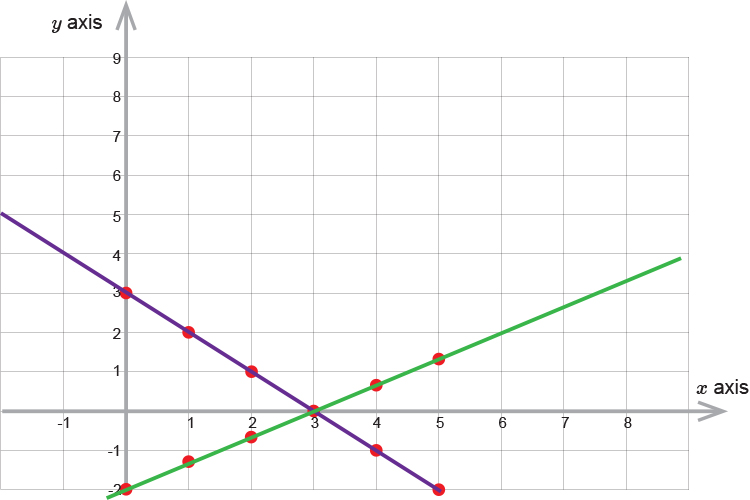Graphical simultaneous equations
We know
Simultaneous equations `=` two equations with two unknowns
and
Graphical = Draw the lines on the graph.
The only additional item you need to know is:

When they meet they find the solution.
(The point where the two lines intersect on a graph is the solution).

If you find where `x` and `y` intersect on a graph that is the solution.
NOTE:
To continue you must understand our section on formula for a straight line.
That is:
- Always make `y` the subject of the formula
- Formula of a straight line is `y=mx+c`
- Plot `x` and `y` for given values of `x`
Example 1
Plot the graphs of the following equations and find their solution by finding the point of intersection.
`2x+3y=6`
`4x-6y=-4`
So first plot the graph of the following equation:
`2x+3y=6`
Subtract `2x` from both sides to get `y` on its own.
`2x-2x+3y=6-2x`
`3y=6-2x`
Divide both sides by 3 to get `y` on its own.
`y=6/3-(2x)/3`
`y=2-2/3x`
Lets plot some points on the graph
| If `x=5` | then | `y=2-2/3(5)` | `=-1.33` |
| `x=4` | then | `y=2-2/3(4)` | `=-0.66` |
| `x=3` | then | `y=2-2/3(3)` | `=0` |
| `x=2` | then | `y=2-2/3(2)` | `=0.67` |
| `x=1` | then | `y=2-2/3(1)` | `=1.33` |
| `x=0` | then | `y=2-2/3(0)` | `=2` |

Now lets add to the graph the equation:
`4x-6y=-4`
Subtract `4x` from both sides to get `y` on its own.
`-4x+4x-6y=-4-4x`
`-6y=-4-4x`
Divide both sides by `-6` to get `y` on its own.
`y=(-4)/(-6)-(4x)/-6`
`y=2/3+(2x)/3`
Lets plot some points on the graph
| If `x=5` | then | `y=2/3+(2times5)/3` | `=2/3+10/3=12/3` | `=4` |
| `x=4` | then | `y=2/3+(2times4)/3` | `=2/3+8/3=10/3` | `=3\1/3` |
| `x=3` | then | `y=2/3+(2times3)/3` | `=2/3+6/3=8/3` | `=2\2/3` |
| `x=2` | then | `y=2/3+(2times2)/3` | `=2/3+4/3=6/3` | `=2` |
| `x=1` | then | `y=2/3+(2times1)/3` | `=2/3+2/3=4/3` | `=1\1/3` |
| `x=0` | then | `y=2/3+(2times0)/3` | `=2/3` |

We can see from the graph that the two lines intersect (and therefore the solution) at:
`x=1` `y=1\1/3`
Example 2
Plot the graphs of the following equations and find their solution by finding the point of intersection.
`y=x+3`
`x+y=7`
So first plot the following equation on a graph.
`y=x+3`
Lets put some points on the graph
| If `x=5` | then | `y=5+3` | `=8` |
| `x=4` | then | `y=4+3` | `=7` |
| `x=3` | then | `y=3+3` | `=6` |
| `x=2` | then | `y=2+3` | `=5` |
| `x=1` | then | `y=1+3` | `=4` |
| `x=0` | then | `y=0+3` | `=3` |

Now lets add to the graph the equation:
`x+y=7`
Subtract `x` from both sides to get `y` on its own
`x-x+y=7-x`
`y=7-x`
Lets plot some points on the graph
| If `x=5` | then | `y=7-5` | `=2` |
| `x=4` | then | `y=7-4` | `=3` |
| `x=3` | then | `y=7-3` | `=4` |
| `x=2` | then | `y=7-2` | `=5` |
| `x=1` | then | `y=7-1` | `=6` |
| `x=0` | then | `y=7-0` | `=7` |

We can see from the graph that the two line intersect (and therefore the solution) at:
`x=2` `y=5`
Example 3
Plot the graphs of the following equations and find their solution by finding the point of intersection.
`2x+2y=6`
`4x-6y=12`
So first plot the graph of the following equation.
`2x+2y=6`
Subtract `2x` from both sides to get `y` on its own
`2x-2x+2y=6-2x`
`2y=6-2x`
Divide both sides by 2 to get `y` on its own
`(2y)/2=6/2-(2x)/2`
`y=3-x`
Lets put some points on the graph
| If `x=5` | then | `y=3-5` | `=-2` |
| `x=4` | then | `y=3-4` | `=-1` |
| `x=3` | then | `y=3-3` | `=0` |
| `x=2` | then | `y=3-2` | `=1` |
| `x=1` | then | `y=3-1` | `=2` |
| `x=0` | then | `y=3-0` | `=3` |

Now lets add to the graph the equation:
`4x-6y=12`
Subtract `4x` from both sides to get `y` on its own
`4x-4x-6y=12-4x`
`-6y=12-4x`
Divide both sides by `-6` to get `y` on its own.
`(-6y)/(-6)=12/-6-(4x)/-6`
`y=-2+2/3x`
Lets plot some points on the graph
| If | `x=5` | then | `y=-2+2/3times5` | `=-2+10/3=-2+3\1/3` | `=1\1/3` |
| `x=4` | then | `y=-2+2/3times4` | `=-2+8/3=-2+2\2/3` | `=2/3` | |
| `x=3` | then | `y=-2+2/3times3` | `=-2+6/3=-2+2` | `=0` | |
| `x=2` | then | `y=-2+2/3times2` | `=-2+4/3=-2+1\1/3` | `=-2/3` | |
| `x=1` | then | `y=-2+2/3times1` | `=-2+2/3=-2+2/3` | `=-1\1/3` | |
| `x=0` | then | `y=-2+2/3times0` | `=-2` |

We can see from the graph that the two line intersect (and therefore the solution) at:
`x=3` `y=0`




